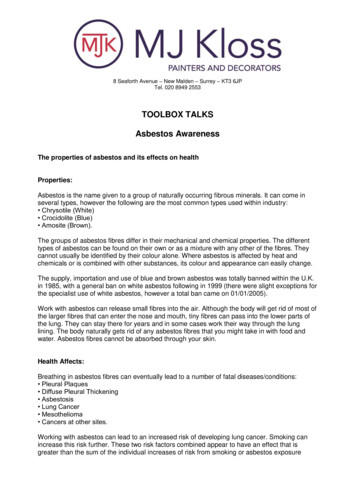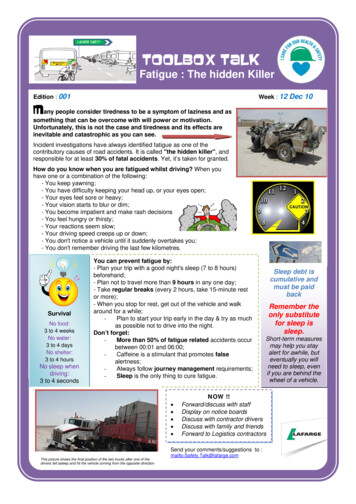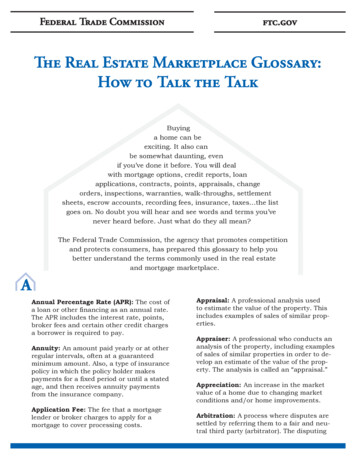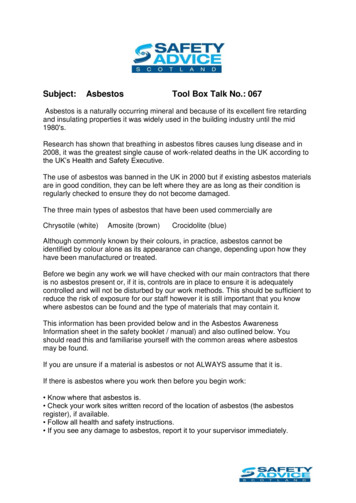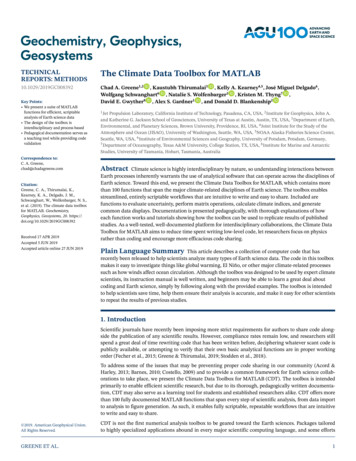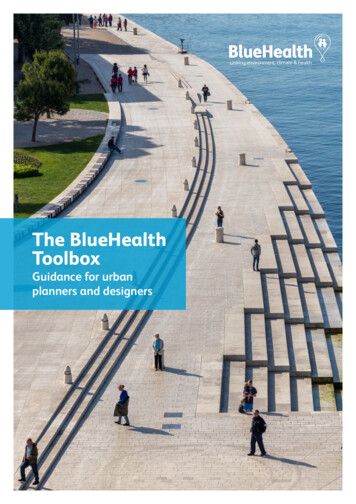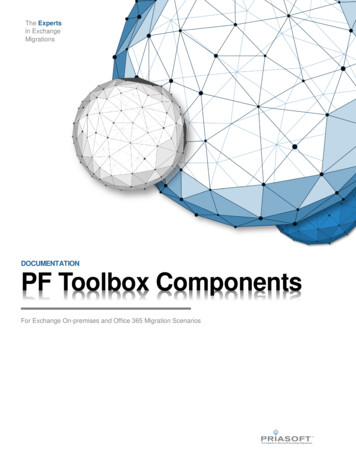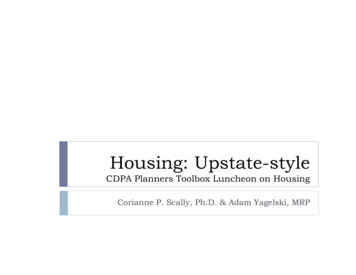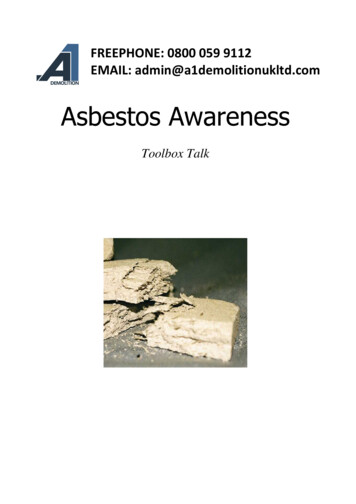
Transcription
FREEPHONE: 0800 059 9112EMAIL: admin@a1demolitionukltd.comAsbestos AwarenessToolbox Talk
ASBESTOS AWARENESSWhy is it a ProblemAsbestos was extensively used as a building material in the UK from the 1950s through to themid-1980s.It was used for a variety of purposes and was ideal for fireproofing and insulation. Any buildingbuilt before 2000 (houses, factories, offices, schools, hospitals etc) can contain asbestos.Asbestos materials in good condition are safe unless asbestos fibres become airborne, whichhappens when materials are damaged.Why is Asbestos DangerousAsbestos fibres are present in the environment in Great Britain so people are exposed to very lowlevels of fibres. However, a key factor in the risk of developing an asbestos-related disease is thetotal number of fibres breathed in.Working on or near damaged asbestos-containing materials or breathing in high levels of asbestosfibres, which may be many hundreds of times that of environmental levels could increase yourchances of getting an asbestos-related disease.When these fibres are inhaled they can cause serious diseases which are responsible for around4000 deaths a year.Asbestos breaks into tiny, long, sharp fibres. They can get lodged and scar the lungs, causingasbestosis or fibrosis.There are three main diseases caused by asbestos: mesothelioma (which is always fatal), lungcancer (almost always fatal) and asbestosis (not always fatal, but it can be very debilitating).Remember, these diseases will not affect you immediately but later on in life, so there is a need foryou to protect yourself now to prevent you contracting an asbestos-related disease in the future.It is also important to remember that people who smoke and are also exposed to asbestos fibres areat a much greater risk of developing lung cancer.Where you will find AsbestosInsulation and sprayed coatings used for:Boilers, plant, pipework in the roof space and also hidden in underfloor ductingFire protection to steelwork, hidden behind false ceilings
Thermal and acoustic insulation of buildingsSome textured coatings and paintsFriction materials such as brake linings and clutch platesGaskets and packings in engines, heating and ventilation systems.Insulating board used in the following places:Fire protection to doors, protected exits and steelworkCladdings on walls and ceilingsInternal walls, partitions and suspended ceiling tiles.Asbestos cement, which is found as:Corrugated roofing and cladding sheets of buildingsFlat sheets for partitions, cladding and door facingsRainwater gutters and downpipes.When am I at Risk from AsbestosWhen you are working on an unfamiliar siteThe building you are working on was built before the year 2000Asbestos-containing materials were not identified before the job was startedAsbestos-containing materials were identified but this information was not passed on by the peoplein charge to the people doing the workYou don't know how to recognise and work safely with asbestosYou know how to work safely with asbestos but you choose to put yourself at risk by not followingproper precautions, perhaps to save time or because no one else is following proper proceduresRemember, as long as the asbestos is not damaged or located somewhere where it can be easilydamaged it won't be a risk to you.You can't see or smell asbestos fibres in the air.The effects of asbestos may take many years to show up - avoid breathing it in now.
Smoking increases the risk many times.Asbestos is only a danger when fibres are made airborneAre you sure that you don't come in to contact with asbestos?If you work in any of the following occupations, and are working on a building built orrefurbished before 2000, you may come in to contact with asbestos:Heating and ventilation engineersDemolition workersCarpenters and joinersPlumbersRoofing contractorsPainters and decoratorsPlasterersConstruction workersFire and burglar alarm installersShop fittersGas fittersComputer installersGeneral maintenance staff e.g. caretakersTelecommunications engineersBuilding surveyorsCable layersElectriciansThis list does not include all occupations where you may come in to contact with asbestos.
Asbestos Insulating BoardFlooringAsbestos Textiles
Electrical SwitchgearAsbestos BitumenAsbestos BakeliteAsbestos Gaskets
Asbestos Ceiling TilesAsbestos Roof Tile Examples
Asbestos CementSprayed Asbestos
Asbestos Lagging
Hazardous workPlumbers, carpenters, electricians and roofers working on building repair are considered most atrisk.Old buildings constructed in the 1950s and 60s may have many forms of asbestos materials usedin them.The removal of roofing felts, cladding, old floor tiles, textured paints and plasters containingasbestos.It's not easy to tell asbestos from how it looks, and it needs to be properly identified in a specialistlaboratory.If you think you've come across asbestos, stop work and tell your supervisor or foreman.Apart from most chrysotile (white) asbestos, where the fibres are firmly linked in a matrix ofcement, vinyl bitumen and the like, crocidolite (blue) and amosite (brown) must only be removedby a licenced contractorWhat Can You do to Protect YourselfRequest the asbestos register or survey results before starting work.Stop and ask if you are suspicious something may be asbestos.Isolate the area and make others aware.What should those in charge of the job do?They must:Find out if asbestos-containing materials are present and plan the work to avoid disturbing thesematerials if possible.Ensure that anyone who is going to work on asbestos material is trained properly and is supervised.Know what work can be carried out on asbestos-containing materials, i.e. does this work need to becarried out by a contractor licensed by HSE.Take account of other risks as well as asbestos, e.g. work at height, and take the precautionsnecessary to do the job safely.Use the equipment and correct methodology to make sure that the job is carried out properlyand that exposure to asbestos is kept as low as possible.
Prepare a plan of work, explaining what the job involves, the work procedures, and what controls touseProvide you with the right equipment, which is clean, in good working order, and protects youagainst asbestosTrain you in using this equipmentMake sure the work area is inspected visually at the end of the job, to check it's fit forreoccupationMake arrangements for the safe disposal of any asbestos wasteConsult the health and safety representative (if there is one)What does the law require?There are a number of sets of regulations, which cover work with all types of asbestos-containingmaterial; they place duties on 'dutyholders', employers and the self employed. A quick summary ofthese regulations can be found in the asbestos regulations.REMEMBER IF YOU SUSPECT ASBESTOS, STOP WORKIMMEDIATELY AND TELL YOUR SUPERVISOR.By signing below you confirm that you have read and understood this asbestos toolbox talk:Name:Signature:Date:
Asbestos Awareness Toolbox Talk FREEPHONE: 0800 059 9112 EMAIL: admin@a1demolitionukltd.com . ASBESTOS AWARENESS Why is it a Problem Asbestos was extensively used as a building material in the UK from the 1950s through to the mid-1980s.File Size: 2MB
